Bivalvia
![]()
This article explains the class of molluscs zoologically known as bivalves. For other meanings, see mollusk.
The bivalves (Bivalvia derived from the Latin word bi-valvius "two-valved") are a class of molluscs (Mollusca). Characteristics of the class are a shell consisting of two calcareous valves and a largely reduced head. They live worldwide in saltwater (80 percent), brackish water, and freshwater and are usually found between 0 and 100 m, rarely to 11,000 m water depth. Mussels live in the seabed, are attached to it or lie freely on it. Most mussel species feed on plankton, which they filter from the water with their gills. Life expectancy ranges from about 1 year to more than 500 years.
Man uses mussels as food and mussel shells as raw material for jewellery, e.g. as a supplier of pearls, souvenirs and in former times also as mussel money. Furthermore, mussels are also used in ponds for purification.
The class contains about 7500 to 10,000 recent and 20,000 fossil species, which are divided into 106 families. According to Huber (2010), about 8000 marine species in four subclasses and 99 families with 1100 genera can be assumed worldwide today. The clam family is the largest marine family with more than 680 species. Another 1200 or so species in seven additional families are known from freshwater. The river and pond mussels are the most diverse family with about 700 species.
Body type
Soft body
In bivalves, the head is reduced. The soft body of the bivalve is covered on both sides by the mantle lobes and encloses the gills and the usually separately sexed gonads. The circulatory system with a heart is open. Typical muscles are the two separate sphincters that pull the two halves of the shell together, the foot retractor muscles, and the mantle retractor muscles. The foot of the shells is mobile and equipped with mucous glands. The nervous system has two clusters of nerve cells: the pedal and visceral ganglion.
Rudiments of the head
Due to the original way of life digging in the sediment, the head is deformed with the exception of the mouth region (that is why Frédéric Cuvier called the molluscs "Acephala", the headless ones, in 1798). Compared to other molluscs, the tentacles, the jaws, the radula and the tongue are only rudimentary. The pharyngeal glands are largely reduced. Next to the mouth opening there are still paired, flat mouth lobes. On these mouth lobes sit in original forms (such as the nut shells) still fimbriated palps, which transport food particles to the mouth opening.
Coat
The soft body of the mussel is covered and protected on both sides by the mantle lobes. The space formed by the two mantle lobes is called the mantle space.
The mantle margin consists of three folds that perform different tasks: The outermost marginal fold forms the shell and shell skin (periostracum), the middle one serves sensory tasks (e.g., dot eyes), and the inner fold regulates the flow of water into the mantle cavity to the gills.
The mantle margin is light-dark sensitive in most species. In swimming bivalves, such as scallops (Pecten) and file bivalves (Lima), which need more precise information about their environment, the mantle margin is occupied by simple ocelli (dot eyes). In the genus Arca, there can be over 200 eyes.
Originally, the mantle margins run separately and parallel to the shell margin (integripalliate). In most species, the adjacent mantle edges are more or less fused together. In some cases, only three openings remain: two openings at the rear end of the mollusk, through which breathing water and food flow into the mantle space and - filtered through the gills - out again, as well as an opening for the foot.
The mantle edge around the respiratory openings of the mantle are often extended tubularly in burrowing or boring mussel species, so that the mussel is also supplied with respiratory water and food in the substrate. The tubular processes of the mantle are called siphons. A distinction is made between a feeding sipho (ingestion sipho) and an executing sipho (egestion sipho). Both can be fused into a retractable double tube, which can be longer than the mussel itself when extended.
In order for this sipho to be retracted into the shell in case of danger, the attachment line of the mantle edge muscles had to recede inwards. This receded attachment line can be recognized in the shell by a more or less pronounced mantle bay of the mantle line (sinupalliate).
Sand clams (Mya arenaria), for example, live buried in the substrate of the Wadden Sea and feed on the sipho. If they are washed out of the substrate, they must die. In contrast, the common blue mussel (Mytilus edulis) sits attached to solid substrate and therefore does not require sipho. It therefore dies if it is buried by substrate.
Symbiotic algae (zooxanthellae) live in the mantle margin of giant clams (Tridacna) and are protected by the clam. In return, the mussel benefits from the photosynthesis products of the algae.
Gill
Evolutionarily, simple pinnate gills for respiration have developed into the more complex filamentous and leaf gills for filtration. The gills of the mollusk, which are located in the mantle cavity, are not only used for respiration, but also for food intake in most species. The gills, like the entire mantle cavity, are covered with cilia that produce a respiratory water stream that can also swirl in food particles. The gill arches produce a mucus in which particles get stuck and are transported to the mouth on cilia. However, unsuitable particles are not swallowed, but are rolled up in mucus into larger pseudofaeces and discharged to the outside with the outflowing water.
Gill types:
- The paired pinnae (ctenidia) each consist of a shaft with several gill leaflets.
- In the filibranchs, W-shaped gill filaments hang in front and behind the foot in two rows into the mantle space. The gill filaments are attached dorsally to the middle tip of the W and the legs of the W are connected to each other by small ciliated structures.
- The net-like false leaf-gills (pseudolamellibranchs) are formed by lateral intergrowth of the gill-threads, i.e. connections between successive "Ws".
- The true leaf gills (eulamellibranchs) are characterized by true tissue bridges between the gill filaments, interspersed with blood vessels.
- The reticulated gills (septibranchs) are narrow, reticulated and fused laterally to the mantle. This adhesion is muscular. In some forms the gills sit in rows of holes in this adhesion which then forms a septum, rarely the gills are completely reduced. Typically, the reticulated gill species are deep-sea dwellers and in some cases actively suck in food.
Circulation system
The vascular system of bivalves, like most mollusks, is open. The heart has two atria and one main chamber. The main chamber is traversed primarily and secondarily by the rectum.
Foot
The originally flat, hatchet-shaped foot of the mussels can take on different shapes such as beam-shaped, tongue-shaped or worm-shaped, adapted to the way of life and locomotion. Swimming and sessile mussel species often have a largely deformed foot. The foot bears the byssal glands, which produce adhesive filaments (70% collagen), especially in juvenile mussels. In some species, adults also produce byssal threads, which the mussels use to anchor themselves to the substrate (e.g., in blue mussels (Mytilidae), ark mussels (Arcidae), scallops (Pectinidae), and pinnipeds (Pinnidae)). The byssal connection can later be severed by the bivalve secretory separation of the filaments (Mytilus) or complete shedding (pearl oysters (Pinctada)). Mussels also use their byssus threads for defense by spinning them into smaller snails, e.g., cage snails (Hinia).
Housing
The shell of the mussel consists of a right and a left flap and surrounds the soft body of the mussel. Both flaps are held together on the back (i.e. on top) with a lock and a lock ligament (ligament). The vertebra (umbo) is the oldest part of the shell. Colours and shapes are very variable. The shell is formed by the mantle, a fold of skin of the mollusk, and there are three layers: the colored shell skin (periostracum), the prismatic layer (ostracum), and the inner calcareous layer (hypostracum). The two halves can be pulled together by two internal sphincters.
Material
The inner shell layers consist mainly of lime, the crystals of which are cemented by means of an organic substance called conchin. The type of lime structures formed has changed in the course of evolution: The original feature is the formation of pearly aragonite. In the now dominant Heterodonta and in the Taxodonta, cross-lamellar aragonite is formed as a derived feature. In parallel, the Pteriida developed the intercalation of calcite.
Calcite also occurs derivatively in the middle prismatic layer, in the Anisomyaria and the extinct Hippuritoida. The calcite and aragonite crystals are arranged in the prism layer in small, angular columns (prisms), which point more or less vertically outwards.
The outer periostracum consists of organic conchiolin and can be variously developed. Most often a thin skin is formed, but "hairs" (e.g. bearded razor clam) and lobed curtains (e.g. Solemya togata) also occur.
Ligament
Actually, the shell is only divided into two halves in the area of the two calcareous layers (ostracum and hypostracum). The outermost shell layer, the periostracum, also covers the shell here, strengthens to form the ligament and thus connects the two shell halves on the dorsal side. This ligament often pulls into the hinge area and thickens to form the resilinum (see Resilin and Abductin). This lock ligament is composed of noncalcifying conchin. This ligament-resilin complex is very elastic and works antagonistically to the sphincters. After the death of the animal, the two shells therefore gape apart and are easily separated by mechanical stress, such as surf, so that usually only single shell halves are found - in contrast to the rarer doublet, which still consists of both valves.
Castle
To prevent the two halves from slipping sideways, they usually bear so-called lock teeth, the formation of which is also the basis of systematic classifications. These lock teeth consist of tooth- or strip-shaped elevations on the inner dorsal edge of the flaps or corresponding pits on the opposite flap, which interlock. Interlocking notches on the lower edge of the shell can also prevent lateral slippage. These notches are also defining characteristics of a bivalve species.
Up to nine different lock types are distinguished:
- taxodont (row-toothed): numerous teeth are placed in a (usually decreasing) row at the edge of the shell (e.g. in ray clams)
- heterodont (differently dentate): few large teeth and max. four secondary teeth (e.g. in Cerastoderma, clam)
- desmodont (ligamentous): two teeth fused into one with spoon-shaped chondrophor, a protruding support of the inner ligament (e.g. in Mya)
- pachyodont (thick-toothed): one to three thick pegs that fit into deep pits on the opposite side
- dysodont (badly toothed): without teeth - only small elevations (e.g. with Ostrea)
- schizodont (cleft-toothed): middle tooth of the left valve usually cleft and framed on the right by two wedge-shaped teeth
- isodont (same-toothed): two to four teeth symmetrically on both valves
- hemidapedont: weakly developed main teeth, only rarely secondary teeth
- anomalodesmatic: without or only with weakly developed teeth, with chondrophor, a protruding carrier of the inner ligament (sphincter cartilage or resilium)
Analogously, the shells of the Articulata, which are not shells but belong to the arthropods, are called locks.
Muscle Prints
The attachment sites of the sphincter muscles (sphincter impressions) and the mantle retraction muscles (the mantle line) play an important role for systematics and determination. Of the sphincter impressions, two of equal size are originally present (isomyar). In the course of evolution, species with sphincter impressions of different sizes (anisomyar or heteromyar) and those with only one impression (monomyar) developed.
The mantle line changed from a simple curved line connecting the two sphincter impressions (integripalliate, cf. the photo of a cockle) to an indented shape (sinupalliate, cf. drawing).
Forms
In color, shape and texture, the shells of the individual species are very different. White and spiny exist as well as elongated, black and smooth shells.
The shell shape of bivalves is adapted to their respective way of life. Since bivalves from different groups often have similar lifestyles, such as filtering water through a sipho while buried in the sediment, they often form similar shell shapes despite being closely related (convergence). The connection between shell shape and lifestyle also allows the reconstruction of the lifestyle of fossil forms and possibly also their habitats.
Holes
Mussel shells washed up on the beach sometimes have circular holes 1-3 mm in size. These are created by predatory snails (mostly Naticidae), which drill the mussel with their rasping tongue and then consume the soft parts.

Convergent shell shapes in bivalves: Panopea and Mya live buried in the sediment
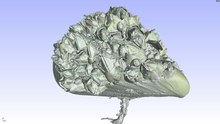
Play media file Computer-animated 3D view of a µCT scan of a young mussel heavily covered with barnacles. Resolution of the scan approx. 29 µm/voxel.
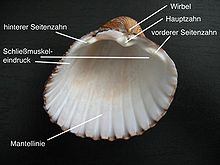
Shell of a cockle, inner view of the left shell valve
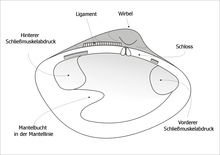
Inside of a left mussel shell
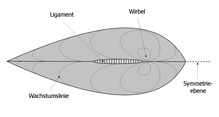
Shell from dorsal (from above), right shell valve below
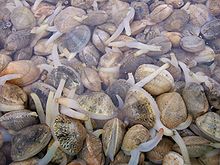
Mussels with sipho

Sand clam with sipho. From Herklots, 1859

With this scallop the dot eyes are to be recognized
Lifestyle
Habitats
Mussels are tied to life in water. They can be found in salt water, brackish water and fresh water, from the Arctic and Antarctic to the tropics. In the Wadden Sea in particular, very large quantities of mussels (such as cockles and mussels) are found in or on the mudflats. They are an important food for seabirds.
The species Enigmonia aenigmatica (HOLTEN, 1803) (an Anomiidae) lives in the tidal spray on mangrove leaves in the Indo-Pacific and corresponds most closely to a terrestrial lifestyle.
As adults, mussels live predominantly in a sessile state, partly on solid surfaces such as rocks or stones, and partly in sand or mud. They therefore belong to the benthos. They are distributed from the intertidal zone to the deep sea.
Locomotion and anchorage
The following modes of locomotion have been observed in mussels:
- footwork
The most common method of locomotion in bivalves is by means of their foot. This part of the body can, for example, be stretched to three times the length of the shell diameter in cockles (Cardiidae). Thanks to their foot, mussels can burrow quickly, crawl in a jerky manner or even jump (Knotted cockle (Acanthocardia tuberculata) from a 20 cm high aquarium). For locomotion the mussels need a suitable substrate, because unlike snails they never have a true crawling foot. Species of the genus Sphaerium are able to move on plants like a spanner by stretching out the foot, sticking the tip and dragging the body.
- By shell rattling free swimming on short distances
Species of the genus Lima swim well, some of the family scallops (Pectinidae) also. They can create a directional stream of water by jerkily folding the halves of their shells together, thus moving a bit through the water according to the rocket principle. Scallops are also said to be able to expel water selectively through the little ears on their sides and thus coordinate their movements more finely, aided by their lenticular eyes.
- anchoring with byssus threads
Some mussels (including blue mussels (Mytilus), pinnipeds (Pinnidae), razor clams (Arcidae) and saddle clams (Anomia ephippium)) spin so-called byssal threads with a secretion from the byssal gland at their foot, with which they adhere to each other and to the substrate. For changes of position, at least mussels can dissolve the byssus threads again with a secretion.
- Firm anchoring with the shell to the substrate
The best known example is the oysters (Ostreidae). Other attached genera: Chama, Pseudochama, some Anomia species, spiny oysters (Spondylus).
- No fixed anchorage, as protected by substrate
Species that bore into substrate such as wood or stone may have restricted movement and reduced shell for protection. Examples: Shipworms and frilled borer.
Nutrition
The mussels were originally sediment eaters, derived filter feeding plankton eaters and special forms such as wood eaters, hunters and bacteria breeders.
The primitive bivalves from the subclass Protobranchia collect edible particles such as protozoa, eggs, larvae and digestible detritus from the surrounding substrate with elongated mouth lobes. The food then travels to the mouth opening via a ciliated gutter.
Most more highly developed bivalves feed exclusively by filtration of their respiratory water. Cilia located in the mantle cavity and on the gills create a directional flow of water that enters through one breathing opening and exits through the other. Solid particles in the breathing water are captured at the gills and travel in a mucus packet to the mouth opening. The usable particles, mostly plankton, are digested, and the rest are excreted in fecal cords. Due to their nutrition by filtration, mussels come into contact with very large quantities of water, which makes them particularly sensitive to pollutants contained in the water and predestines them as bioindicators.
Drilling molluscs (Teredinidae) use special enzymes to digest the wood in which they drill.
Some, possibly most, species of Septibranchia belonging to the Anomalodesmata (including the club shells) are hunters, actively sucking in small crustaceans with the help of their muscular septum in the mantle cavity.
The giant clams (Tridacna) and species of the genus Solemya live with symbiotic photosynthesizing algae in the mantle margin, and deep-sea species on black smokers keep sulfide bacteria in special structures of their gills.
Reproduction and development
Most mussel species are separately sexual; there are both male and female animals. Fertilization and subsequent larval development take place externally in the water. The release of eggs and sperm may be hormonally coordinated in giant clams (Tridacna), for example. After development through a larval stage of the Trochophora or Veliger type, the larva develops into the juvenile mussel after metamorphosis, which during its adolescence looks for a suitable place where it can spend its adult life. In blue mussels (Mytilus), oysters (Ostrea) and other colony-forming species, the young mussels usually remain near the colony and subsequently attach themselves not only to the substrate but also to other mussels. This is how, for example, the mussel beds of the blue mussel are formed as they are known from the Wadden Sea.
The species of molluscs living in fresh water show very different methods of reproduction and development. These groups of molluscs, like the groups of snails living in freshwater and on land, have adapted strongly in the course of their development to the changeable living conditions that distinguish freshwater from the relatively constant conditions in the sea. The Unionida group, which includes the large bivalves native to Central Europe (painter's, brook, pond and river pearl mussels), develops via a parasitic larval stage, the so-called glochidia, which must successfully attach themselves to a fish swimming past in order to develop further.
In contrast, most small freshwater bivalves (pea bivalves (Pisidium) and spherical bivalves (Sphaerium)) are hermaphrodites that give birth to living larvae (ovoviviparity). The wandering clam (Dreissena polymorpha), on the other hand, which belongs to the triangular clams, develops, like its marine relatives, via a veliger-like planktonic larval stage.
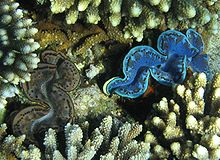
Giant clams are with up to 140 cm length and 400 kg weight the largest still living mussels
Questions and Answers
Q: What are bivalves?
A: Bivalves are a class of molluscs, also known as pelecypods, that have a hard calcareous shell made of two parts or 'valves'.
Q: What is the structure of a bivalve shell?
A: The bivalve shell is made of two parts or 'valves' that are hard and calcareous.
Q: How many species of bivalves are there?
A: There are over 30,000 species of bivalves, including the fossil species.
Q: Where do bivalves live?
A: All bivalves live in the water, most of them in the sea or in brackish water. Some live in fresh water.
Q: What do bivalves eat?
A: All bivalves are filter feeders, which means they eat tiny microalgae. However, a few are carnivorous and eat much larger prey.
Q: What are some examples of bivalves?
A: Clams, mussels, scallops, and oysters are some well-known examples of bivalves.
Q: How many living species of bivalves are there?
A: There are about 9,200 living species of bivalves in 1,260 genera and 106 families.
Search within the encyclopedia